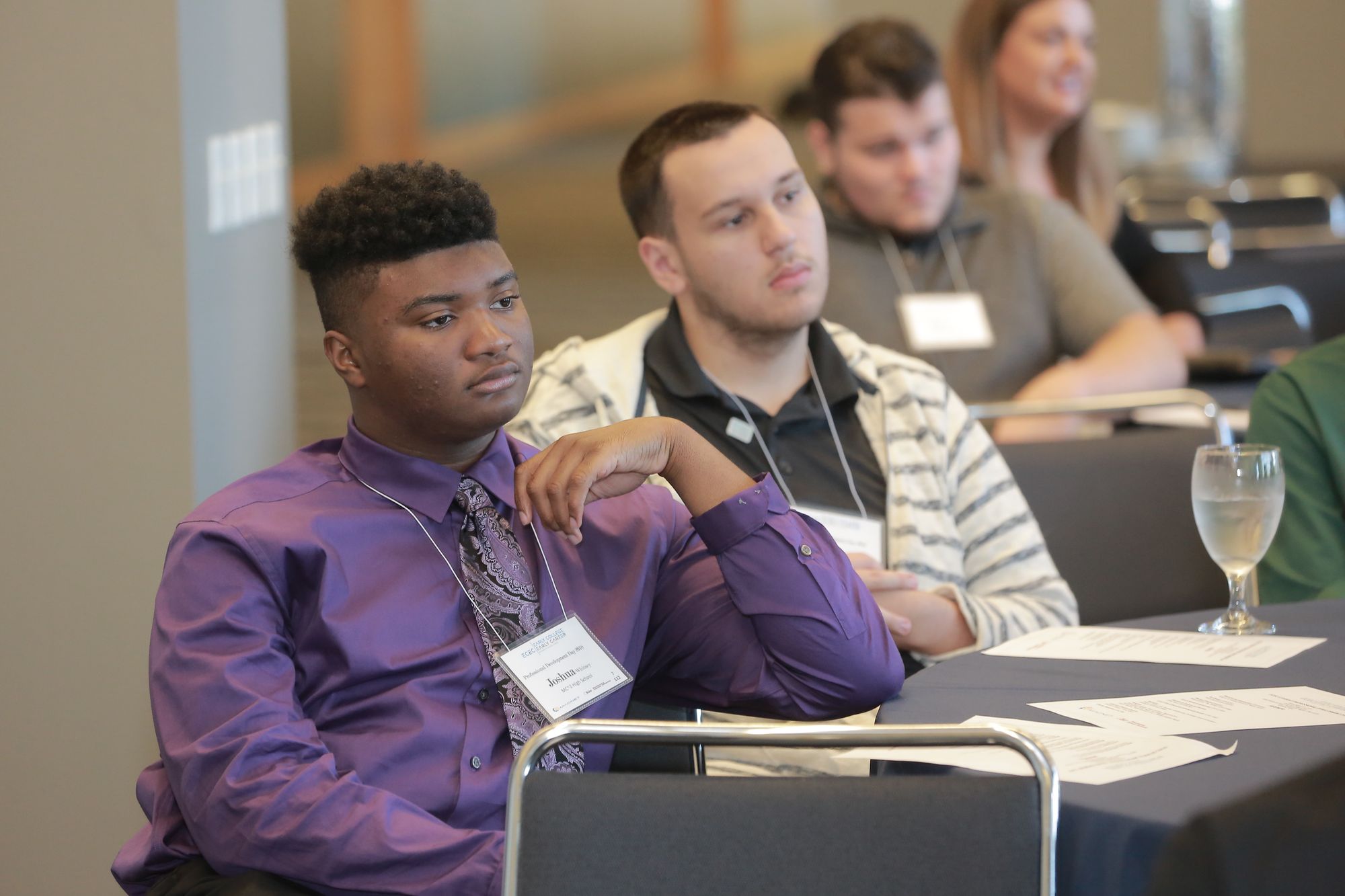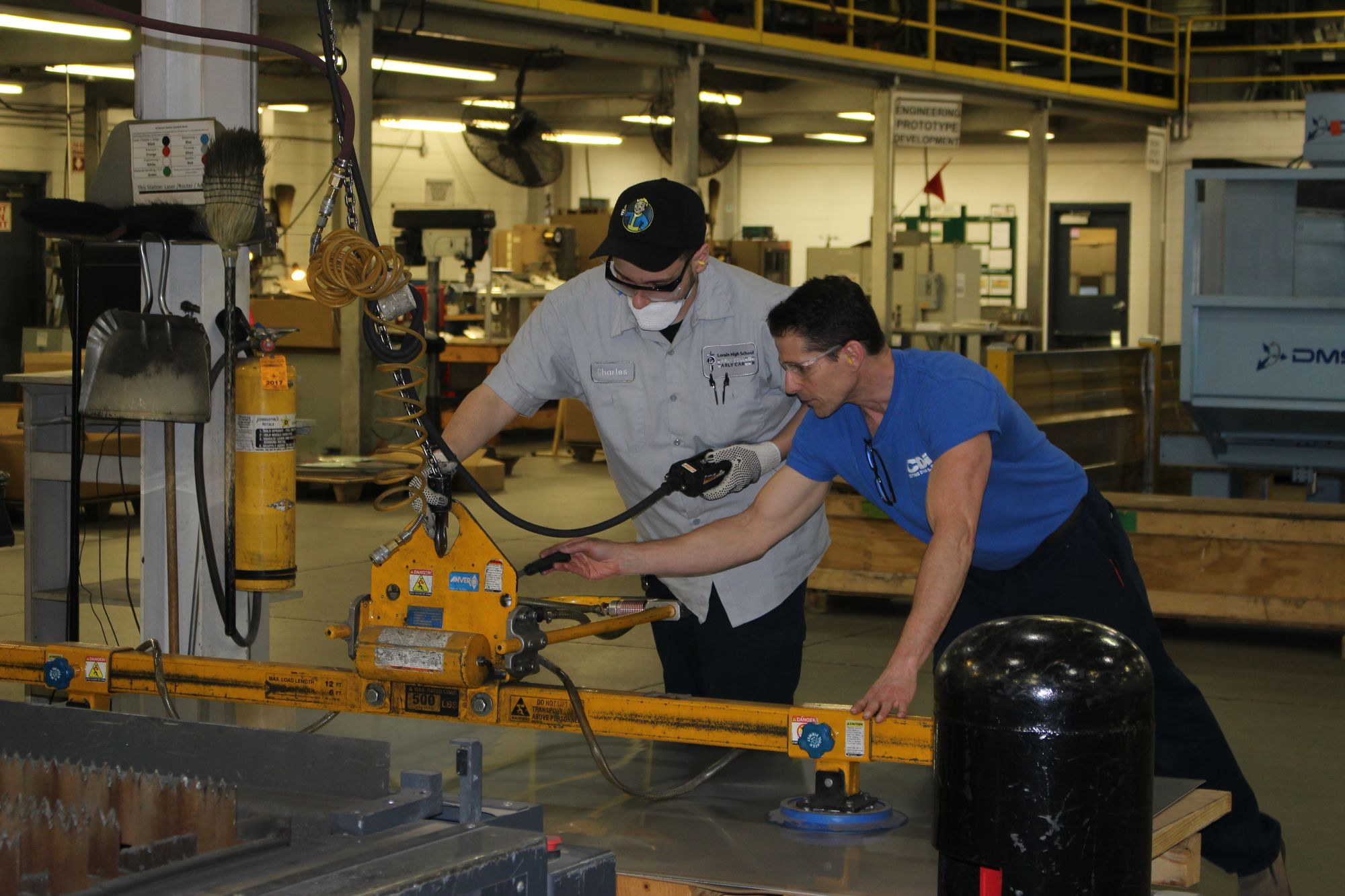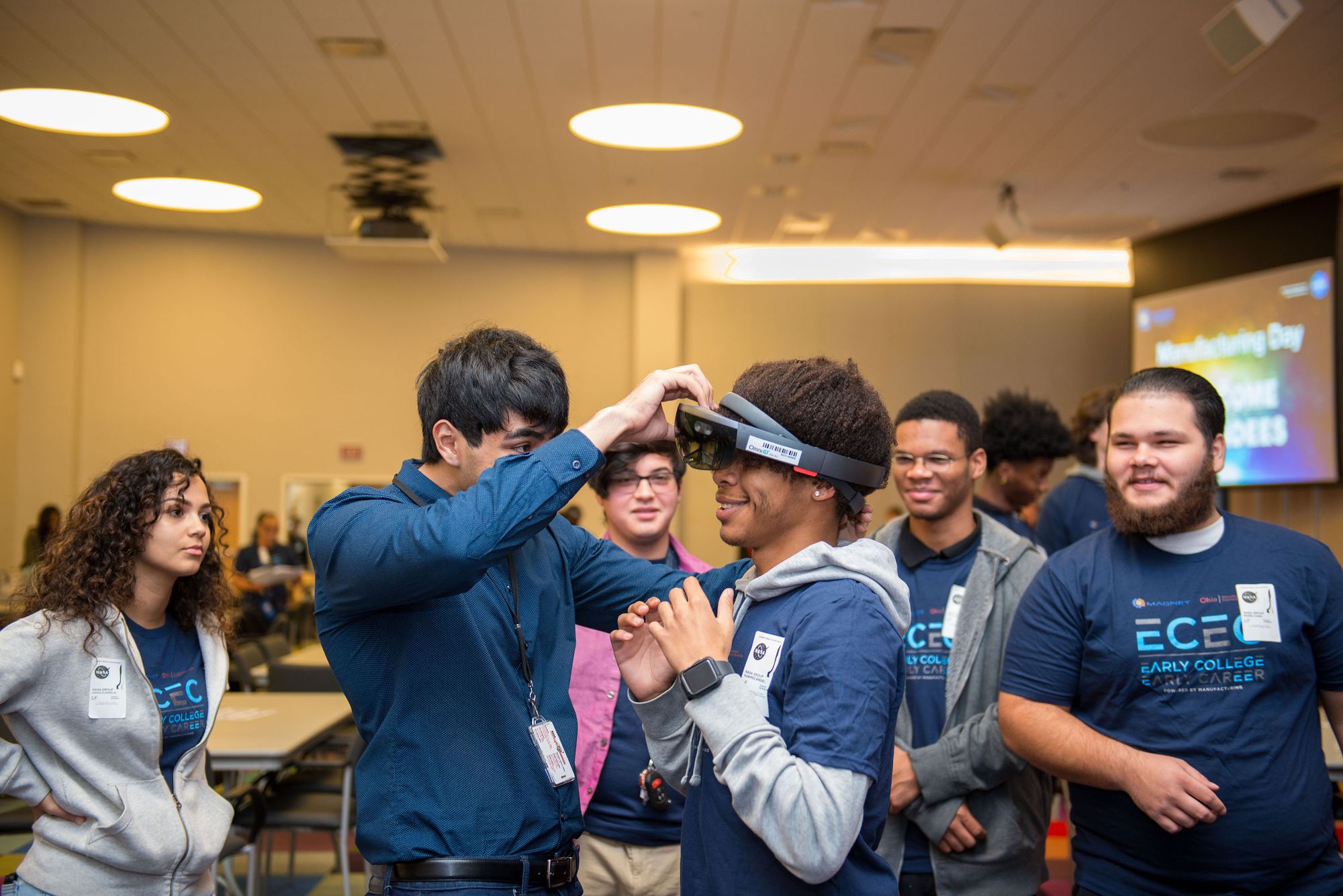Early College, Early Career: Bridging Education and Manufacturing for Ohio’s Youth
Revitalizing STEM education, growing manufacturing companies, and strengthening communities.

Brief Introduction, History, & Background
In 2017, The Manufacturing Advocacy and Growth Network (MAGNET) launched a new workforce development program: Early College, Early Career (ECEC). ECEC adapts European-style manufacturing apprenticeships to Ohio schools, providing 9th and 10th grades exposure to careers and opportunities in manufacturing and 11th and 12th graders college classes, opportunities to earn manufacturing certifications, work in paid internships, and professional development and soft skills training. ECEC fits under one of MAGNET’s three main tracks of programming: Growth Services, Workforce Development, and start up services. MAGNET is a non-profit consulting group who, for over 30 years, has helped Northeast Ohio manufacturers grow their businesses through hands-on consulting, engineering assistance, and worker training programs. MAGNET collaborates with manufacturing CEOs, governments, community leaders, and educators to solve problems and build opportunities. MAGNET is part of the National Institute of Standards and Technology (NIST) and Ohio Manufacturing Extension Partnership (MEP) program which supports small and medium manufacturers across the US.
The development of ECEC started in 2015. Eight companies, many of which have an executive presence on MAGNET’s board, put together research on ways to grow manufacturing in the region, create a workforce, help manufacturers recruit and retain employees, and establish a long-term solution to close the skills gap. The other component of the research was how to focus on youth, especially those still in high school. The research pointed toward the opportunity that lies in youth apprenticeships and early exposure to manufacturing. This decision was highly influenced by the board chair from Germany who had extensive experience with the industry apprenticeship programs. The board took the white paper’s recommendations and made them a priority. After two years of planning, MAGNET launched ECEC with eight host companies.
Autumn quote:
“Early College Early Career really speaks to our belief that no one should have to choose between college or a career. We wanted to create a program that provided various pathways for high school students to access a viable career in manufacturing. ECEC was designed to prepare those that choose college, and those that choose to enter the workforce after graduation. Our program, very intentionally, has different components available to students that support the advancement of either decision.”
About Early College, Early Career
ECEC is an employer-led initiative with ten companies - including Swagelok, Lincoln Electric, Nordson Corporation, and Parker Hannifin - as the initial core. ECEC combines many different elements to create a comprehensive career pathway. These elements are built around the goals of heightening the awareness of manufacturing careers to not only high school students, but also parents, and educators.
Students, starting in the ninth grade, are introduced to careers and opportunities in manufacturing. MAGNET works with members of the initiative to offer plant tours, provide guest speakers representing diverse and under-represented populations, and create engaging online videos to introduce students to rewarding careers in manufacturing. In many cases, the same activities used to introduce students to manufacturing careers are attended by teachers and parents. To increase awareness about manufacturing in general and share different career pathways, MAGNET goes to participating high schools and presents to 10th grade students the ECEC program, explain the ECEC application process, drill down about what the program offers, and the commitment level that is required. Through a combination of self-selection, teacher recommendations, parent engagement, and employer interviews, students join the ECEC cohort. If school administrators or a teacher thinks the student is a good fit for the program, they provide a recommendation. Students work full-time in the summer between junior and senior year. During their 11th and 12th grades, students have the opportunity to earn up to 15 college credits taking courses that map to an Associate’s degree in Advanced Manufacturing Technology through community college partnerships. 12th grade students in the ECEC cohort spend up to 12 hours per week working in paid internships.

Students in the ECEC program are starting their career pathway while still in high school. Students have the opportunity to earn industry credentials through training and course work. The college classes are paid for through the Ohio state College Credit Plus (CCP) program. ECEC employers offer tuition reimbursement to employees to promote ongoing education, and students are eligible for this benefit once hired. Having costs associated with attending college courses covered reinforces the education to career path and removes the debt that often prevents commitment to higher education. The employers also treat the internship as a stepping stone into future employment. Companies see the two-year commitment to the student as an investment and a test run with a potential employee. The learning while working combination sets a new standard for what it means to be a skilled worker: ongoing learning is not only necessary; it is promoted and a great way to increase opportunities.
MAGNET’s staff - led by Autumn Russell, Vice President, Diversity and Inclusion, Early College, Early Career, and Brittany Becker, Program Manager of Early College, Early Career - are responsible for building relationships across the manufacturing ecosystem. Relationships such as finding employers to offer internships, plant tours, be guest speakers, and mentors; engaging with high schools to participate in the ECEC program; and collaborating with community colleges and training centers who offer courses needed to work towards credentials and certificates. The relationship-building work requires many different types of engagement. For example, when working with high schools, some connections start with school district-level administrators who approach MAGNET, in other cases an individual school principal or career pathway coordinator learns about MAGNET and invites them to share information. Depending on who in the school is championing the idea, there may be a need to educate administrators, principals, and teachers about the value of the program and the motivation behind ECEC.
To navigate relationships with employers and students, MAGNET created the Internship Coach and Mentorship roles. The Coach works with both the student intern, making sure they are prepared with soft and technical skills, and the employer, acting as a liaison between the intern, the company, and MAGNET. They have regular weekly conversations directly with the intern’s supervisors about any immediate concerns and Autumn leads monthly conversations at a higher level, to find out how the partnership is progressing. This communication is vital to help manage expectations of everyone involved and to increase the likelihood of long-term success for everyone. If issues arise in the workplace that may come from culture clashes - between the employer and students - then MAGNET can coach the student and make recommendations to the company to address the issue(s). If issues arise outside of the workplace that are impacting a student’s ability to commit to the work, the Mentor gets more involved. Mentors are full-time MAGNET staff and responsible for tracking student engagement and academic performance as well as developing relationships, identifying barriers that students may have, and then linking students to resources to address those barriers. The internship Coaches and Mentors make sure students have what they need in order to be successful through the program.
MAGNET has also filled in other roles and responsibilities as the program has had early success and uncovered issues. For example, MAGNET provides transportation, taking students to work or community college, and their Education Coordinator organizes the additional training. MAGNET has also developed an understanding and links to the support networks in and around the high schools where their ECEC cohorts are learning. This allows them to connect students, and employers, to resources which help students stay on the career pathway.
Autumn Quote:
“We try to bring parents along, as we are educating and informing students, we're also doing the same for parents and for school partners. What we really want to do is get them to understand manufacturing and how it has evolved, how it's different, debunking some of those myths that manufacturing is dark, dirty, and dangerous and instead showing the advancement of the industry and the career opportunities.”

Keys to Success
Collaboration is the first key to success from Autumn’s point of view. In the ECEC program, partners - employers and schools - are included in decision-making. This creates buy in and establishes accountability and sense of ownership of results. In 2020, MAGNET started having more consistent strategic discussions with ECEC employer partners to drive a continuous improvement process. Before any big decisions are made about how ECEC works, partners are brought to the table to give feedback to ensure an inclusive process. Individual teachers and parents are part of the collaboration too. They play a big role in the recruitment process because they are likely to see an awareness and interest in a student that would typically be hard to uncover just through an interview or application.
Ongoing improvement and data-driven decision making also plays a big part in MAGNET’s success. While all key components have been in the ECEC program from the beginning, they have gone through iterations. For example, from the beginning MAGNET had mentorship in a contracted role, and the mentor that would engage with 40+ students. MAGNET quickly learned that relationship development was very important with students. Now mentorship is an in-house position and more accessible and available to students more often. Another example of an improvement is the hiring and interviewing process. A representative from MAGNET and employer interview prospective students together. This has led to more inclusive hiring practices and helped make better pairings between talented students and employers.
Brittany quote:
“We want to make sure that the flow of communication is there, between a supervisor working with one of our students, the student, and MAGNET. Consistent communication allows us to address any issues, whether performance-based or cultural-based. There can be translation issues that stems from people coming from different cultures and generations.”

Outcomes
In 2020 MAGNET received a grant from the National Science Foundation to create a robust system to measure outcomes. MAGNET works with two external partners to access and track student data, as well as Ohio’s central repository for all employment, salary, and educational data. Reporting has shown that 84% of students who successfully completed the program are currently in manufacturing careers, college, or combination. ECEC participation also shows a significantly higher scholastic achievement and graduation rates compared to non-ECEC students. Research shows that high school students taking courses in-line with college curriculum and career readiness are more likely to apply to college and find early job placement. ECEC has not been in operation long enough to show big outcomes, but early data is in line with these findings. There are also positive outcomes for those students who explore other paths. Should a student not want to attend college and they pursue work somewhere other than where they interned, they have their industry certification.
From the start, ECEC built in a commitment to racial, gender, and socioeconomic equity to their program. ECEC is bringing educational and work opportunities to predominately inner-city, low-income youth, with 78% of ECEC students coming from low-income, predominately African American, communities. MAGNET has also improved its outreach to female students, increasing the percentage participating from 18% in the first cohort to 22% in 2019. In 2019, nearly 600 9th- and 10th-grade students learned about manufacturing careers in an intensive, culturally appropriate, and meaningful way. And 70 11th and 12th graders were placed in paid internship positions while also taking high school and college courses and getting professional development coaching. In the internship position, students earned an average of 10,000-$15,000, while training for their future.

The Future [Scaling]
MAGNET has seen growth each year: more students, parents, and teachers attending manufacturing awareness events; more students participating in ECEC cohorts; more schools partnering; and more employers hosting interns. The pandemic impacted the recruitment process and slowed down some of the growth, which has created a space and opportunity to evaluate the scaling process. The question to define a scaling strategy is: how can MAGNET build a better and sustainable ECEC model post-pandemic? A sustainable ECEC starts with increasing student recruitment. MAGNET is evaluating how to increase the number of students involved and what is the most effective way of doing that: adding another school with only a handful of students the first year or getting new students from one of the 10 schools they are already working with. And while historically high schools have been the primary recruitment partner, MAGNET is considering building relationships with new community-based organizations to find interested students.
Autumn also recognizes that future growth is dependent on the economics of running the program. After the early learning and changes, ECEC is in a position to better understand the cost of the program overall, and per student. With their data collection and reporting process happening in parallel, MAGNET can understand how investments in different staff, events, partners, etc. impact outcomes; this gives them a chance to optimize costs and increase or decrease investments in different aspects of ECEC. The second component to financial sustainability is diversified funding. In 2020, ECEC was 100% grant funded, 85% coming from philanthropic grants. MAGNET and partners are exploring how to attract investment and revenue. This means looking into possible funding through the public school system because MAGNET and partners are contributing to student education, providing fee for service work for employers since they are providing HR related services, and working with the state to utilize funding tied to traditional workforce development models and using them to run ECEC which is a new strategy in the state of Ohio.
The last element needed to scale is ongoing education of people and organizations - teachers, administrators, parents, employers, other workforce development organizations - about manufacturing and diversity, equity, and inclusion. MAGNET is involved in helping make a larger culture shift: changing the minds of parents, teachers, and students about manufacturing; changing the perception that college is the only path to higher education; changing how employers hire, train, and respond to, what they perceive as, a non-traditional workforce.
This case study was originally published by Urban Manufacturing Alliance in collaboration with The Century Foundation in 2021 as part of “Manufacturing Workforce Strategies Building An Inclusive Future: How community-embedded workforce organizations center racial equity, credentialing, and training to create stronger neighborhoods,” a report highlighting best practices from eight workforce organizations in connecting diverse communities to opportunities in manufacturing.